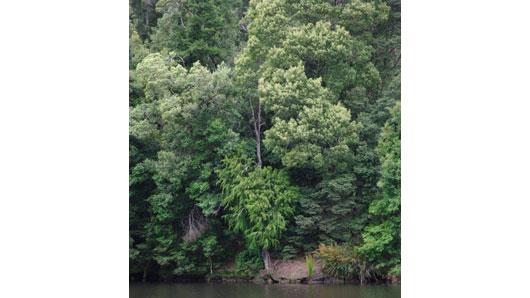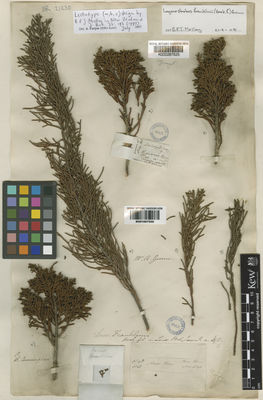Huon pine is a slow-growing Australian tree, some individuals of which are thought to be over 2,200 years old.
Contrary to its common name, Huon pine is not a member of the true pine family (Pinaceae) but instead belongs to the Podocarpaceae. The generic name Lagarostrobos comes from the Greek words for narrow (lagaros) and cone (strobilos), whilst the specific epithet franklinii commemorates Sir John Franklin, the Arctic explorer, who was Lieutenant-Governor of Van Diemen's Land (Tasmania) from 1837-1843. Huon pine takes its common name from the Huon River in Tasmania, along which it grows.
This slow-growing tree has lax, open seed cones and buoyant seeds, which allow it to disperse along watercourses. Some living trees have been estimated (by boring into the trunk and counting rings) to be over 2,200 years old. Huon pine reproduces not only by seed, but also vegetatively (by layering and suckering), allowing unique genetic individuals to persist for an extremely long time.
Geography and distribution
Restricted to Tasmania (Australia), where it occurs mainly in the southern and western parts. Huon pine is usually found growing along rivers, up to 750 m above sea level.
Description
An evergreen, predominantly dioecious tree (with male and female cones occurring on separate trees), growing up to 30 m tall. The trunk is up to 2 m in diameter at chest height and has fibrous, longitudinally grooved, grey-brown bark up to 6 cm thick, which peels off in scales and strips.
Young trees have more or less conical or pyramidal crowns, whereas mature trees have more spreading crowns. Layering (the process by which branches develop root systems on coming into contact with the ground) can produce genetically identical individuals that cover large areas of ground.
The slender branchlets are 1-1.2 mm in diameter, including the scale leaves. The leaves are in spirals and have conspicuous, scattered stomata (the pores through which gas exchange occurs).
The pollen cones are 4-6 mm long, 2-2.5 mm wide and are borne on the ends of the branches. The seed cones are 4-5 mm long and consist of 5-10 fertile bracts in spirals, each bract with a single ovule. There are up to eight seeds per cone, usually fewer. The light brown seeds are enclosed in a dry, papery epimatium (swollen appendage).
Threats and conservation
About 85% of the area in which Huon pine occurs is now protected, and the cutting of living trees is banned. Despite the fact that nearly all the large trees were removed by previous logging, it is not now considered to be threatened. An estimated 15% of its habitat has been lost to fire and artificial flooding (for hydroelectric projects) over the past 100 years, but regrowth (often from suckers) has taken place in almost all the remaining suitable areas.
The greatest current threat is fire, and fire management practices are now a priority. Even with the current conservation measures that are in place, it will take many centuries to restore the wealth of large trees that were cut by loggers along all of the rivers where it occurs.
Uses
Huon pine was once the most important timber tree in Tasmania, and almost all the large trees were felled and exported as timber in the 19th century. But the exploitation of this slow-growing tree proved unsustainable and is now banned. The hard and durable wood was used for boat-building, in particular for the decks of sailing ships. It is still permitted to make use of dead and fallen wood in some areas, and this is used for wood crafts and cabinet-making. Products made from the wood have additional appeal due to the Huon pine's status as one of the longest-living trees in Australasia.
The essential oil of Huon pine is used as a 'perfuming agent' (described as having a sweet, woody, spicy, cedar wood aroma) in products such as medicinal soaps.
Millennium Seed Bank: Seed storage
Kew's Millennium Seed Bank Partnership aims to save plant life world wide, focusing on plants under threat and those of most use in the future. Seeds are dried, packaged and stored at a sub-zero temperature in our seed bank vault.
Description of seeds: The seeds float on water and are dispersed by freshwater currents. Seeds are also dispersed by birds
Number of seed collections stored in the Millennium Seed Bank: None
Cultivation
Lagarostrobos franklinii is cultivated as an ornamental in some botanical collections and arboreta, but this slow-growing tree is not common in cultivation.
This species at Kew
Huon pine can be seen growing in Coates Wood at Wakehurst.
Pressed and dried specimens of Lagarostrobos franklinii are held in Kew's Herbarium, where they are available to researchers by appointment. The details of some of these, including an image, can be seen online in the Herbarium Catalogue.
Kew's Economic Botany Collection contains samples of the wood of L. franklinii.





